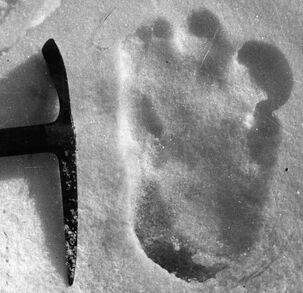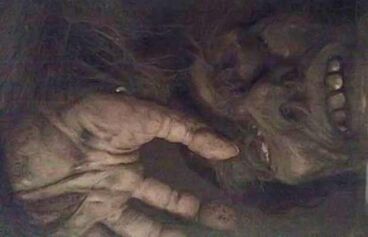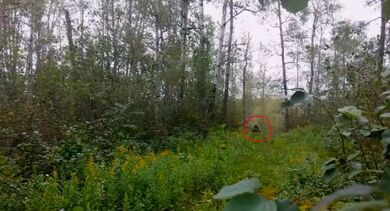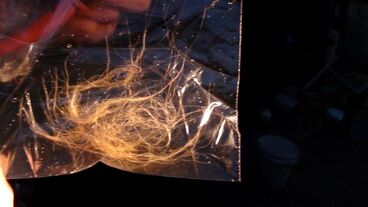
A yeti footprint
Is Sasquatch mere legend or a remarkably elusive reality? What's the evidence? Personal accounts of sightings are plentiful and deserve weight because of their numbers. Physical evidence, such as footprints and hair samples, is rarer, and recordings on film and video rarer still. Here's a look at some of the best - and always controversial - evidence for the existence of Sasquatch.
Footprints
He isn't called Bigfoot for nothing. There have been more than 900 footprints attributed to Bigfoot collected over the years, having an average length of 15.6 inches. The average width is 7.2 inches. That's one big foot. By comparison, the foot of a 7-foot, 3-inch basketball player - a rarity, to say the least - is 16.5 inches long but only 5.5 inches wide.
The first documented discovery was in the cold winter of 1811 in Alberta, Canada, when David Thompson discovered a large set of footprints in the Rockies, impacted deep in the snow. Thompson was convinced the tracks he found did not belong to a bear.
Through 1958 and 1959, Bob Titmus and others found numerous Bigfoot tracks in the area of Bluff Creek where the famous Patterson/Gimlin film was shot several years later. It was here that the first Bigfoot print was cast, and "Bigfoot" was brought to the media.
In 1969, a trail footprints leading through the snow was discovered in Bossburg, Washington. The tracks were 17 inches long and gave researchers the indication that there was a crippling deformity on the right foot. This analysis has given the Bossburg Sasquatch the name "Cripple Foot". There were approximately 1,089 footprints in all, probably the greatest number of Bigfoot prints ever found in one area!
In 1982, prints were discovered by the U.S Forest Service in the state of Washington that appeared to possess dermal ridges (fingerprints for the foot) and sweat pores. The footprints were found similar to that of a primate. After much analysis, many researchers have concluded that these could not have been faked.
Years later, in 1988, wildlife biologist John Bindernagel of Vancouver Island found massive footprints in the snow and heard a "whoo-whoo whooop" call in the woods. His evidence includes 16-inch, human-like footprints found in Strathcona provincial park while hiking. In addition, Bindernagel said he heard a strange, ape-like call at a friend's cabin near Comox Lake in 1992. Bindernagel said he knows of no other creature in North America that makes such a call, and he believes it was a Sasquatch trying to communicate with its own kind.
Dwellings and Graves
Although by no means verified or authenticated, there have been claims of discoveries of Sasquatch dwellings and even burial sites:

Dallas Gilbert says he has had several encounters with Bigfoot, but his most controversial claim is for that of a possible Bigfoot community and burial site. Gilbert's story is weakened by his reluctance to disclose the exact location of the site. However, he has told The Daily Times of Portsmith, Ohio, "There are places where you can see territorial markings and snaps that the creature has made in the trees. There are even canopies and bows made of trees for him to sleep under." The burial site is marked by a stone, according to Gilbert. "It looks like a tombstone almost," Gilbert said. "You can see the outlines of the creature's eyes, head and his teeth." No corpses or other remains have been recovered from the area, so all we have is Gilbert's word on these claims.
In 1995, Terry Endres and two friends were researching an area known for Bigfoot sightings for a local cable TV show. They chanced upon a large, dome-shaped structure constructed of branches and brush. It was large enough for three full-grown men to sit in and was obviously not a natural occurrence.
Sound
Not many people have heard the lonely, chilling cries and howls of Bigfoot. But those who have, and know the sounds of the wilderness,

Bigfoot Sounds
say it's an unforgettable sound like no other.
Outdoorsman Bill Monroe, a writer for the Portland Oregonian, recounted his experience in an article for the newspaper. Monroe was elk hunting when the stillness of the late afternoon was broken by an eerie sound. "The deafening screaming, choking, belching moan from the ridge was chilling." he wrote. "The kind of scream that sends mothers scurrying to find their children. The kind of scream no cougar or bear could ever squeeze from their throat... unless it was their last. Piercing, echoing, guttural; a single, horrible high-pitched-yet-throaty, inhuman, unnatural creation of Steven Spielberg that makes your skin crawl."
In the early 1970s, Al Berry, Ron Morehead and several friends camping in the Sierra Nevada Mountains of Eastern California experienced what they believed to be a close encounter with the Sasquatch species. Throughout the course of several months, strange sounds were heard that carried throughout the vast wilderness surrounding their deer-hunting lodge. These sounds, recorded by Al Berry with a portable tape-recorder hung on a tree branch, are thought to be Sasquatch vocalizations, possibly a language.
In 1984, Bruce Hoffman was prospecting for gold near the Clackamas River. He told investigator Greg Long this story: "I had to park a couple hundred feet from the river, and I had to walk a little ways back towards the small stream that was running into the river. And just before I got to the small tributary, I would say from one-eighth of a mile to a quarter of a mile away, down in the woods I started hearing this yell, or a call. The sound had a base tone, a muscular sound to it, and the sound got loud. You could hear how it went up through the trees and up to the sky. The sound traveled about three to four miles to the ridge of the mountains. You could hear the sound hit the mountain."
Smells

Invariably, the sighting of a Sasquatch is accompanied by a very strong, very foul odor.
In June, 1988, Sean Fries was camping on the north fork of California's Feather River. "I climbed into my tent and lay down on my bedroll. I let my dogs run around because they always stay close to camp. I started to dose off when suddenly I woke up. It was dead quiet - no crickets, nothing, and my dogs came running into my tent shaking. I grabbed my rifle and flashlight and stepped outside the tent. I couldn't see anything, but I had that sensation of being watched. Then I heard some very heavy footsteps right behind me in the trees. There was also a very strange odor, almost like a cross between a skunk and something dead. This thing circled my camp site all night long."
Hair Samples

Bigfoot hair sample
Tufts and strands of hair thought to come from Sasquatch have not added to the weight of evidence for the reality of the creature. Most hair samples tested prove to be that of bears or other non-primates. Promising samples were obtained in 1995 by Freeman, Laughery and Summerlin.
The hair samples gathered by the three men were sent to Ohio State University for DNA analysis. Dr. W. Henner Fahrenbach "determined microscopically that the hair appeared to have come from two individuals of the same species, that it differed in color, length, and hair growth cycle between the two sets, had not been cut, and was indistinguishable from human hair by any criterion."
Ultimately, the tests were inconclusive. The researchers said that the "DNA extracted from both hair shaft or roots (hair demonstrably fresh) was too fragmented to permit gene sequencing."
Footage and Photos
Photos, film footage, and video of Sasquatch are extremely rare. At worst, they are murky, fuzzy, and inconclusive. At best, when they

Pennsylvania White Bigfoot - slowed down
are clear, they are highly controversial and suspected of being hoaxes.
The term "blobsquatch" was coined to describe such photographic evidence of Bigfoot without a discernible subject.
The Patterson/Gimlin film is by far the most famous and most scrutinized footage ever taken of Bigfoot. Roger Patterson and Robert Gimlin shot the footage in 1967 with a 16 mm camera while on an expedition to find the elusive creature in the Bluff Creek area of the Six Rivers National Forest in Northern California. Large footprints had been found in this region in previous years. Debate among various "experts" over the authenticity of the film has been ongoing for 30 years. In recent years, some people have come forward to claim that they participated in the hoaxing of the film, but even their testimony has been called into question.
In September, 1998, David Shealy took 27 photographs of the 7-foot-tall creature in the Everglades. "I had been sitting up in the tree for about two hours every night for the past eight months," Shealy said. "I dozed off for a little while, and when I woke up, I saw it coming straight at me. At first I thought it was a man, but then I realized it was the skunk ape." Shealy followed the tracks of the animal and made what he said could be the biggest skunk ape discovery: small footprints he says appear to be from a baby skunk ape. Shealy now estimates there are between nine and 12 skunk apes roaming the Everglades, and said most people who have spotted the creature usually see them in groups of three or four.

Bigfoot patterson tiagopsc
Pattersom/Gimlin Bigfoot Footage
